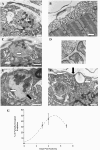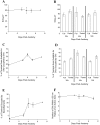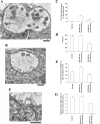Ultrastructural correlates of synapse withdrawal at axotomized neuromuscular junctions in mutant and transgenic mice expressing the Wld gene
- PMID: 14529044
- PMCID: PMC1571169
- DOI: 10.1046/j.1469-7580.2003.00214.x
Ultrastructural correlates of synapse withdrawal at axotomized neuromuscular junctions in mutant and transgenic mice expressing the Wld gene
Abstract
We carried out an ultrastructural analysis of axotomized synaptic terminals in Wld(s) and Ube4b/Nmnat (Wld) transgenic mice, in which severed distal axons are protected from Wallerian degeneration. Previous studies have suggested that axotomy in juvenile (< 2 months) Wld mice induced a progressive nerve terminal withdrawal from motor endplates. In this study we confirm that axotomy-induced terminal withdrawal occurs in the absence of all major ultrastructural characteristics of Wallerian degeneration. Pre- and post-synaptic membranes showed no signs of disruption or fragmentation, synaptic vesicle densities remained at pre-axotomy levels, the numbers of synaptic vesicles clustered towards presynaptic active zones did not diminish, and mitochondria retained their membranes and cristae. However, motor nerve terminal ultrastructure was measurably different following axotomy in Wld transgenic 4836 line mice, which strongly express Wld protein: axotomized presynaptic terminals were retained, but many were significantly depleted of synaptic vesicles. These findings suggest that the Wld gene interacts with the mechanisms regulating transmitter release and vesicle recycling.
Figures



References
-
- Aberle H, Haghighi AP, Fetter RD, McCabe BD, Magalhaes TR, Goodman CS. Wishful thinking encodes a BMP type II receptor that regulates synaptic growth in Drosophila. Neuron. 2002;33:545–558. - PubMed
-
- Balice-Gordon RJ, Chua CK, Nelson CC, Lichtman JW. Gradual loss of synaptic cartels precedes axon withdrawal at developing neuromuscular junctions. Neuron. 1993;11:801–815. - PubMed
-
- Barker D, Ip MC. Sprouting and degeneration of mammalian motor axons in normal and de-afferentated skeletal muscle. Proc. Roy. Soc. B. 1966;163:538–554. - PubMed
-
- Bixby JL. Ultrastructural observations on synapse elimination in neonatal rabbit skeletal muscle. J. Neurocytol. 1981;10:81–100. - PubMed
Publication types
MeSH terms
Substances
LinkOut - more resources
Full Text Sources
Molecular Biology Databases

